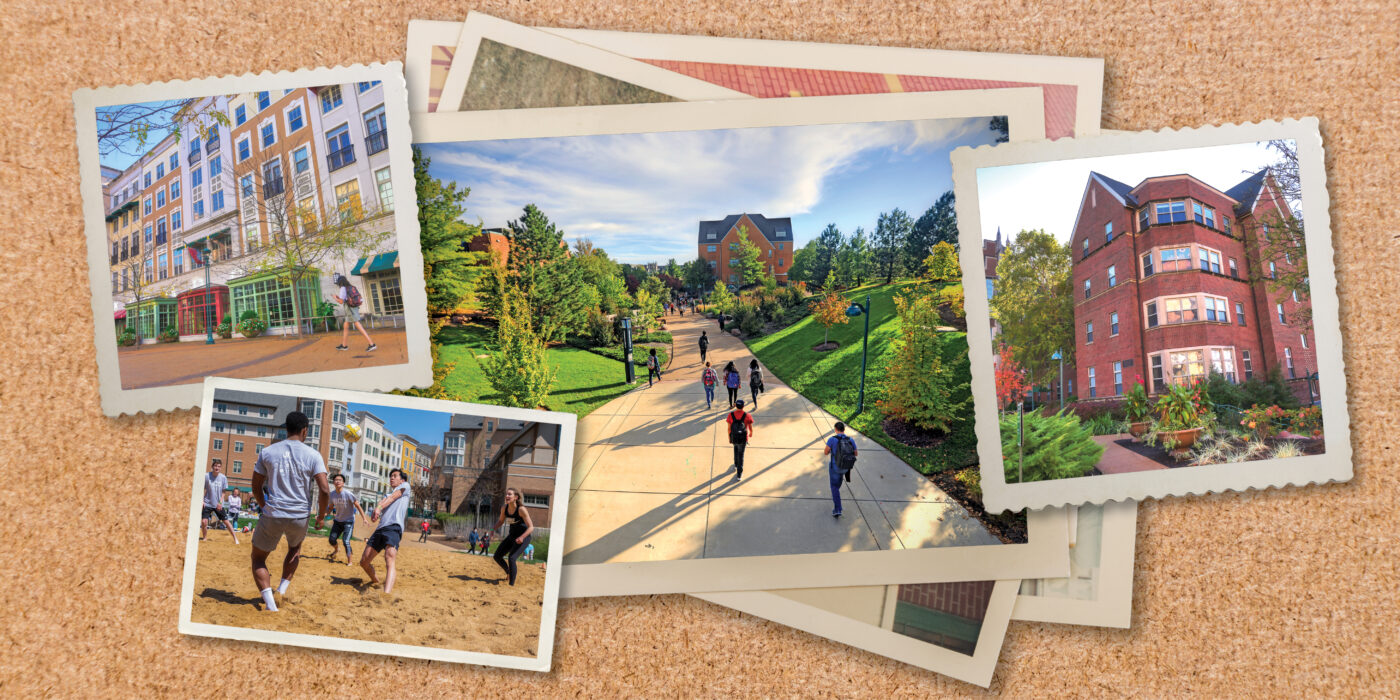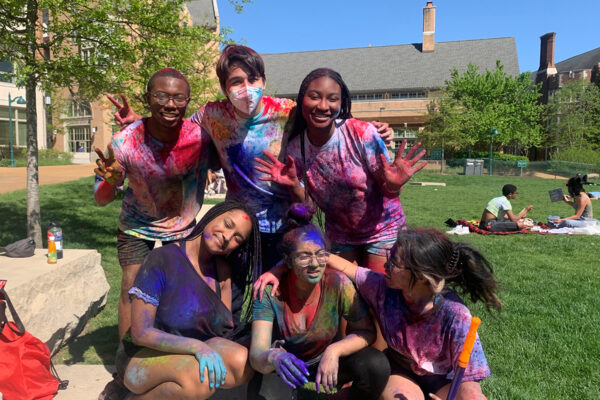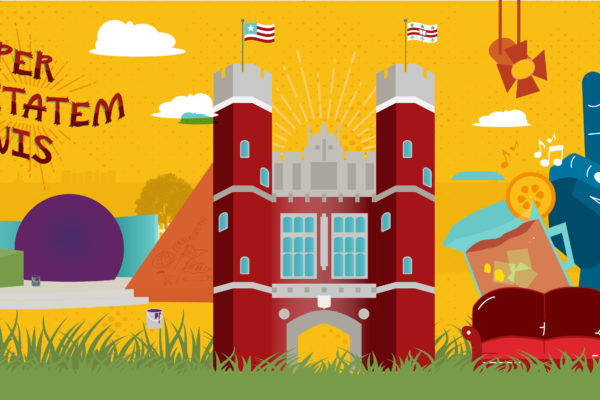Rob Wild, AB ’93, loved his first-year dorm: Rubelmann Hall, aka Ruby. One of the first four dormitories built on the South 40 in the late 1950s, Ruby had cinder block walls, communal bathrooms and sliding windows that opened onto the Swamp.
“Some of my best WashU memories happened on Ruby 1,” recalls Wild, who went on to serve as a resident advisor (RA) in Wydown East, now Mudd House, and in the original Umrath Hall.
“But Rubelmann was built to meet the needs of a different time, back when WashU needed to add beds if it was going to be more than a streetcar school.”
Fast forward to today. Wild is still here, serving as associate vice chancellor for student affairs and dean of students. But Ruby is long gone, razed in 2015 to make way for Umrath House, one of 21 new or renovated residential halls on the South 40.
Today’s campus housing boasts private bathrooms, high-end memory foam mattresses, kitchens and spaces to meet and play. In addition to comfy amenities, Washington University Student Associates (WUSAs) and RAs help students acclimate academically and socially, and faculty associates and fellows introduce students to university resources and St. Louis’ sites and culture. Students can get their bangs trimmed or pick up a bag of Sour Patch Kids from a student-owned business, catch a comedy show at Black Box Theatre or shoot hoops on the Swamp. Both Princeton Review and Niche have named WashU’s residence halls the best in the nation. But rankings tell only part of the story, Wild says.
“It’s the community that matters,” Wild says. “The Faculty Fellows who invite students over for pancakes, the university staff who deliver programs and services, the students who run the STEP businesses and perform the shows and plan the events — these are people who make WashU feel like a home.”
“Whereas once the South 40 felt like a commuter suburb — a place where you go to sleep and study — now it’s a vibrant, pedestrian community.”
James Kolker
James Kolker, university architect and associate vice chancellor, says every study nook, pathway and courtyard is designed in service of this greater mission. Take, for instance, “the Spine,” which travels from the South 40 sculpture “Swamp Creature Friends,” across the Bear’s Den courtyard up to the Clocktower, along the STEP storefronts and past McLeod’s Way benches, through the Underpass and on to the Danforth University Center.
“These are the elements of a small town,” explains Kolker, noting that the Spine is the most traveled route on campus. “Whereas once the South 40 felt like a commuter suburb — a place where you go to sleep and study — now it’s a vibrant, pedestrian community.”
The same is true of the Village on the northwest corner of the Danforth Campus; and off-campus residences such as the Lewis Collaborative, which features 93 graduate student apartments on Kingsland Ave., in University City; and the Lofts, the newest Residential Life community located on Delmar in the heart of The Loop.
Washington University guarantees housing for all undergraduates. All 1,800 members of the Class of 2026 will live on the South 40. And some 3,030 returning students have chosen to live in university housing. WashU also has expanded housing options for graduate students.
Soon, WashU will begin to plan the next generation of university housing. Traditional dorms like Beaumont and Lee, and first-generation suites like Shanedling, Dauten and Rutledge, are showing their age.
“Now it’s time to think about the next 50 years,” Kolker says. “The world has changed — the student body has changed, expectations have changed, sustainability aspirations have changed. So, we are taking a step back and studying the ways residential life connects to academics, health and wellness, and all the other elements of campus life so that the residential experience can better contribute to the overall WashU experience.”
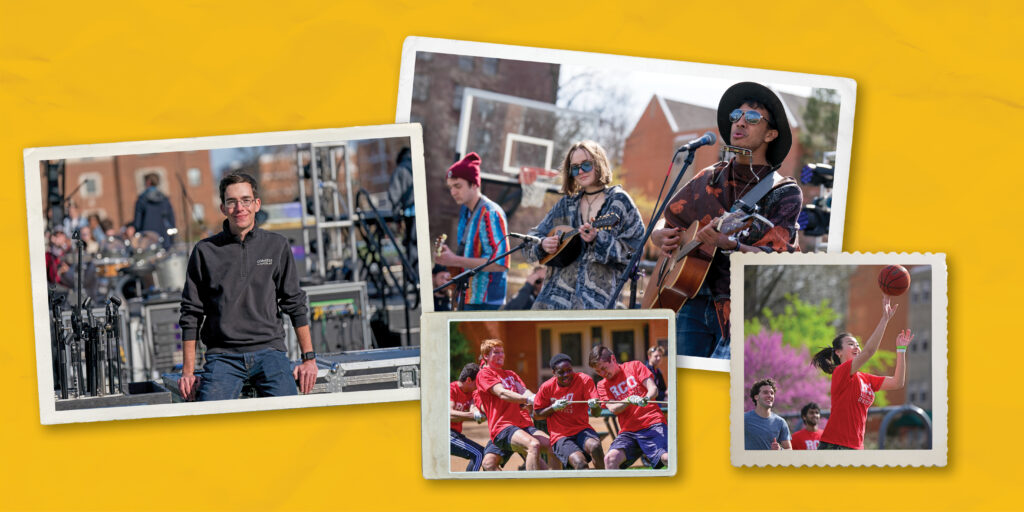
Finding your place
Raised in Stark, Kansas, population 74, junior Matthew Inman is a first-generation college student. He didn’t know a lot about dorm life when he arrived at WashU in 2020, but he had some ideas.
“You hear these stories about that amazing first-year experience — meeting your roommate, finding your best friend, having that first romantic relationship,” Inman says.
Due to the COVID-19 pandemic, Inman got none of that. He didn’t get to tour campus before moving into Liggett-Koenig Residential College. He didn’t get a roommate, because all students were assigned single rooms. And relationships — well, it’s hard to get to know someone over Zoom.
But Inman did find an outlet in Congress of the South 40 (CS40), one of the largest programming organizations on campus. CS40 hosts events like WUStock and helps Residential College Councils organize their own programs, meet sustainability goals and advocate for students.
“I was involved with student government all four years in high school, so when I learned about CS40 and the college councils, I thought, ‘That sounds pretty cool. I’ll give it a try,’” Inman says. “More than anything, I was just happy for an excuse to talk to people for an hour a week
on Zoom.”
“These traditions are a big part of the WashU culture, and bringing them back has been an important step toward getting back to our roots.”
Matthew Inman
This year, Inman served as the CS40 director of services and oversaw the return of WUStock, which showcased four campus bands, and Residential College Olympics, where hundreds of South 40 and Northside residents competed in flag football, sand volleyball, basketball, chess and other games. This year’s winner was Brookings Residential College (aka the Bees).
“It was just a phenomenal feeling watching everyone together, cheering,” says Inman, who lived in the Village last year. “These traditions are a big part of the WashU culture, and bringing them back has been an important step toward getting back to our roots.”
Inman, who is studying political science in Arts & Sciences, also serves as an aspirational peer mentor for the Deneb STARS, a cohort program for first-generation and lower-income students. That experience, along with his service in CS40, prompted him to apply to be an RA. He was accepted and has been assigned to Hitzeman, Hurd and Myers Residential College.
“I know what it’s like to come to WashU and have no idea what’s going on,” Inman says. “As an RA, I’d like to give first-years the confidence to go to office hours for help with courses, introduce them to all of WashU’s fun traditions, and tell kids like me that they will find their place.”
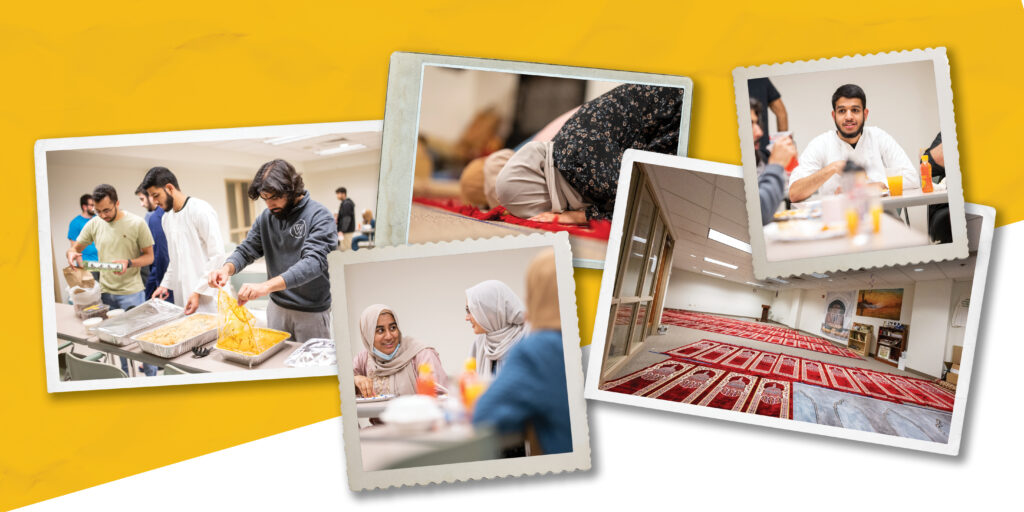
Exploring shared interests
Junior Zainab Mairaj came to WashU to study statistics and environmental analysis. But she also wanted to learn more about her Muslim faith.
“Growing up in a predominantly white town, I didn’t know many other Muslims,” Mairaj says. “So, living with other Muslims and learning about their cultures and traditions has been a really important part of my time at WashU.”
Mairaj is a member of Sakeenah, a Residential Life Living Learning Community (LLC) for Muslim students located in the Village. Sakeenah’s 16 members pray in the Lopata Reflection Room, play Mario Kart in the common room and celebrate holidays with adviser Younasse Tarbouni, a teaching professor of Arabic in Arts & Sciences. Mairaj and her two roommates were the first women to join Sakeenah since its founding in 2019.
“It isn’t always easy to be a Muslim in America, especially if you wear the hijab. But here, I feel supported and understood.”
Zainab Mairaj
“It isn’t always easy to be a Muslim in America, especially if you wear the hijab,” Mairaj says. “But here, I feel supported and understood.”
To junior Ilyas Mehkri, a neuroscience major in Arts & Sciences, the Sakeenah Living Learning Community is more than a collection of suites. It’s the scent of samosas and biryani at Iftar, the evening meal shared during Ramadan, and the colors of kurtas and thobes, types of Islamic clothing.
“You walk into the common room and smell all the scents. Everyone is like, ‘Ooh, what’s that? Where’s that from?’” Mehkri says. “All the different foods, ways of dressing, ways of praying — it has really opened my eyes to the fact that there’s no one way to worship or live life.”
Residential Life started the LLC program in 2018 to support groups of sophomores, juniors and seniors who wanted to explore a shared interest or culture in a residential setting. And Residential Life provides LLC residents advising from university faculty and funding for programs such as retreats, lectures and meals.
In the past, female STEM majors and members of the Beta Omicron Kappa literary honorary have formed LLCs in Millbrook Apartments and the Lofts, respectively. And this academic year, Hamsini LLC, located in a former fraternity house, will welcome students who are interested in exploring the history and culture of the African diaspora. Residents will gather for Sunday dinners and participate in programming from the Department of African and African American Studies.
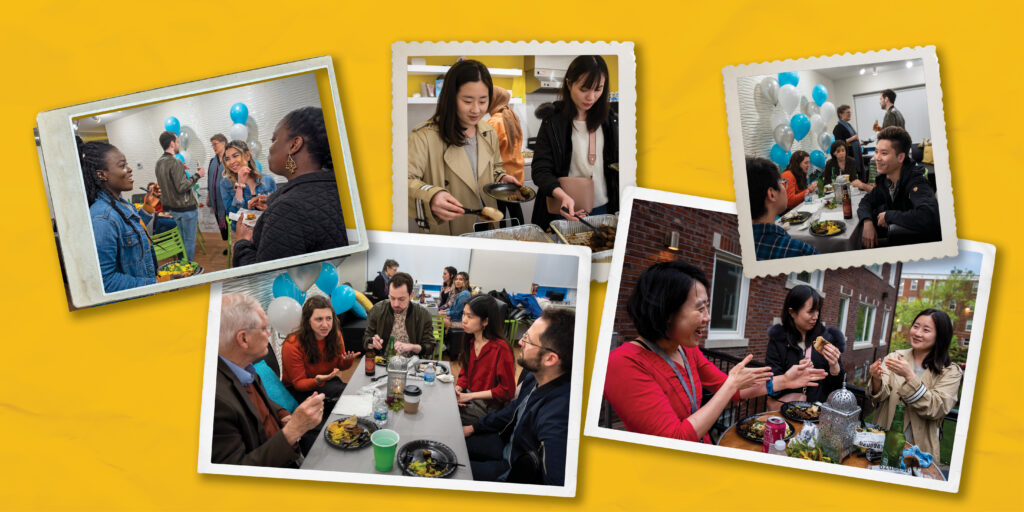
Graduate housing builds affinity
Back in 2016, Mary Campbell, associate vice chancellor for real estate, set out to
re-create the South 40 experience for graduate students — and why not, WashU undergraduate housing is among the nation’s best. But when she pitched the concept to students of the McDonnell International Scholars Academy, they took a hard pass.
“They told us flat out, ‘We don’t want anything like you have on the South 40. Our housing should be different because we are different,’” recalls Campbell, who oversees the university’s portfolio of 1,400 off-campus apartments.
So, Campbell asked architecture students in the Sam Fox School of Design & Visual Arts to work with McDonnell Scholars to transform two neighboring apartment buildings into affinity housing that would meet their unique needs. The results surprised her.
“We got out of their way, and it was a good thing because we never would have come up with what they designed,” Campbell says. “We had imagined a giant gathering room with glass walls for programming. But what they wanted was a variety of spaces throughout the buildings, a community kitchen and big outdoor space. That’s what we gave them, and it’s been a success.”
In 2017, McDonnell Scholar Weiyi Pan moved into the complex located just north of campus. He’d enjoyed dorm life in China but was ready for some privacy.
“It’s fun because we have MBA students, students studying literature, students studying medicine. I hear opinions different from mine, and that expands my vision as a student, as a person.”
Weiyi Pan
“I was so excited to finally have my own bathroom,” says Pan, who graduated in May with a doctorate in environmental and chemical engineering from the McKelvey School of Engineering. “That was one of the appeals of the program — that I could live with other scholars from all over the world but have my own space.”
Pan says scholars come together in all sorts of ways in the building: They use the community kitchen to make dumplings and birthday cakes, the sunny courtyard to study, and the common rooms to throw happy hours.
“It’s fun because we have MBA students, students studying literature, students studying medicine,” Pan says. “I hear opinions different from mine, and that expands my vision as a student, as a person.”
The university has since created similar affinity communities for the Chancellor’s Graduate Fellows and the Spencer T. and Ann W. Olin Fellows, and offers affinity housing for graduate students in chemistry, political science and other academic programs.
More recently, WashU unveiled Core Apartment Residences, located in the former Shriners hospital near the School of Medicine, and the Lewis Collaborative, located in the Lewis Building off the Delmar Loop. Core boasts 60 apartments and offers a fitness center and library and a fourth-floor terrace with beautiful views, while the Lewis Collaborative features 93 residential units, a coffee shop, a communal kitchen and flexible classroom space for use by the Center for the Humanities in Arts & Sciences. Once an afterthought, graduate affinity housing is an important way to recruit and support students, Campbell says.
“Students want experiential graduate housing. They’ve always wanted it,” Campbell says. “And now we’re finding exciting ways to deliver.”
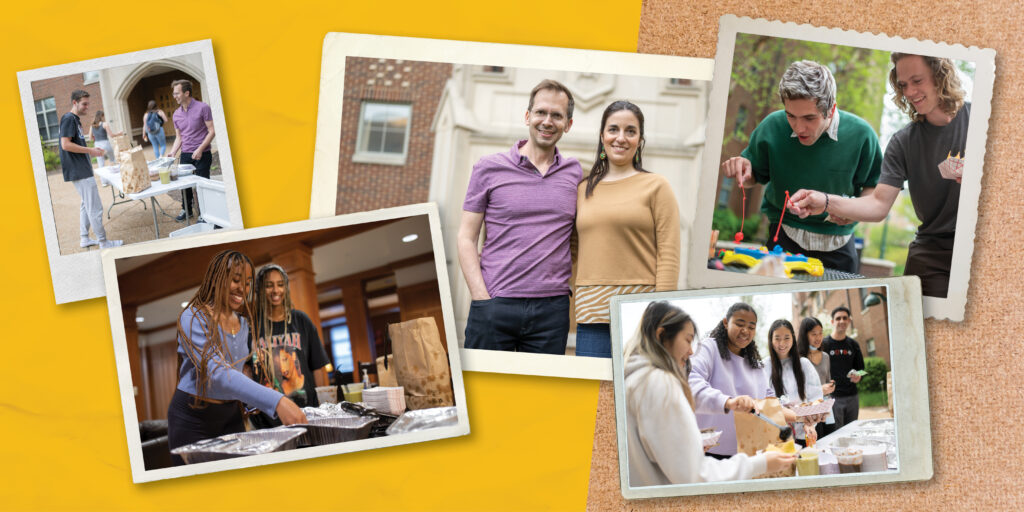
Faculty as family
As every parent knows, living with a teenager can be tough. Now imagine living with 270 of them.
That’s life for William Acree, professor of Spanish in Arts & Sciences and faculty fellow for the Liggett-Koenig (LK) Residential College, and his wife, Cecilia Hanan Reyes, who serves as project coordinator for the Office of the Provost. For three years, the couple, along with their 8-year-old daughter, Sophia, have hosted taco dinners, delivered care packages, led trips to the Sheldon Concert Hall and drawn messages of support for students in sidewalk chalk.
Acree volunteered to be a faculty fellow after traveling with first-year students to Argentina and then organizing outings for a South 40 floor as a faculty associate.
“As professors, we see bits and pieces of students in the classroom. But as fellows, we can see the whole student.”
William Acree
“I could see how an outsider would find it strange that there is an actual waitlist to live among college students,” Acree says. “But our students are so eager to drink up the college experience, and it’s been amazing to be part of that and to get to know them more fully. As professors, we see bits and pieces of students in the classroom. But as fellows, we can see the whole student.”
Among the first universities to establish a residential faculty program, Washington University launched its initiative in 1997. Today, nine residential colleges have faculty fellows living in their communities, hosting programs that include career panels, yoga classes, bonfires and more. Stephanie Weiskopf, associate director of residential faculty engagement, says the program breaks down the barriers between faculty and students.
“The idea is if students are experiencing faculty as real people with real lives in the residence halls, then they will experience them as real people in the classroom — people whom they can approach with questions or ask for help,” Weiskopf says. “Students also tell us that, quite frankly, they feel a little better knowing the fellows are there. Yes, there are the RAs and the college directors, but the fellows make them feel as if they have a family here looking out for them.”
The program not only impacts students; it changes the faculty, too, says Weiskopf.
“Every single faculty fellow says they have a clearer understanding of students and their intricate lives and the challenges they face,” Weiskopf says. “It also has made the fellows champions for students in department meetings and among their peers.”
That certainly has been the case for Acree, who says his years as a faculty fellow have transformed his teaching and made him a more empathic educator. It also has changed the way he thinks about higher education and the university’s mission.
“Whenever discussing course planning or new course ideas, I often think of what students in LK have told me about classes they’ve loved or would like to see taught, or some of the big problems they’re eager to explore in the classroom,” says Acree, who was also a part of WashU’s strategic planning process.
“My residents also tell me how important it is for them to connect with faculty through research. So, when thinking about questions of undergraduate research support, how we encourage our students to take the WashU mission out into the world, or the literacies we would like them to cultivate, I always have LK students in mind.”
